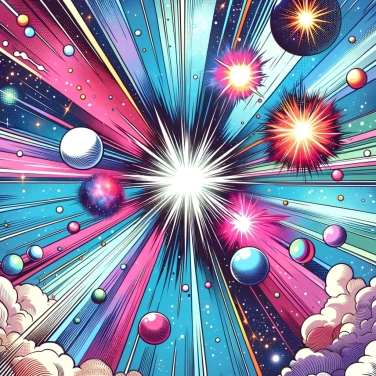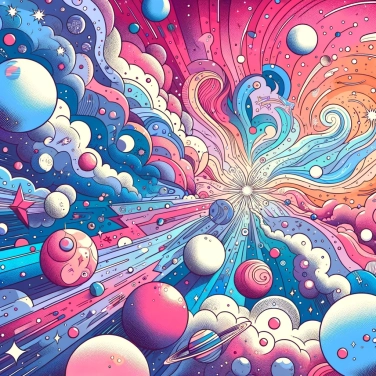The color of supernovas varies according to their type because it is determined by the chemical composition of the exploding star, influencing the temperature and density of the ejected elements, and therefore the color of the emitted light.

There are mainly two major families of supernovae: type Ia supernovae and those known as core-collapse supernovae (types Ib, Ic, and II). Ia supernovae originate from a white dwarf, a small super-dense star, that gradually siphons material from a neighboring star until it reaches a critical mass; the result: it explodes with very stable brightness, making it a perfect cosmic benchmark! The other type, core-collapse supernovae, are generally massive giant stars that die out of nuclear fuel. The balance is lost, and BAM: the core collapses violently before rebounding in a monstrous explosion. Depending on their original outer envelope and chemical composition, these supernovae exhibit different spectral characteristics, thus varying colors.
The composition and initial temperature of a star greatly influence the observed color of a supernova. For example, a massive star destined to become a Type II supernova is rich in hydrogen, with a very hot core often exceeding several hundred million degrees before explosion. In contrast, white dwarf stars that explode as Type Ia supernovae lack hydrogen and are primarily composed of carbon and oxygen, with internal temperatures lower than their massive counterparts. These differences in chemical composition and internal temperature directly determine the light spectrum we observe, the result of a rapid chain reaction within the star that causes its spectacular, bright, and… colorful explosion.
The colors of supernovas primarily come from their temperature and the chemical elements ejected at the moment of the explosion. A very hot star produces intense blue or white light. Conversely, a cooler star mainly emits red or orange light. When it explodes, a lot of heavy elements are expelled: iron, calcium, oxygen, and many others. Each element leaves a particular luminous signature called spectral lines, which colors the light of the supernova. For example, Type Ia supernovas contain a lot of iron, giving them a rather bright, bluish-white color. In contrast, Type II supernovas (originating from massive red giant stars) are richer in hydrogen and emit a more reddish light. The brightness evolves over time as the temperature gradually decreases, and certain elements become increasingly visible. This change affects the observed color in the sky depending on the type of supernova and the evolutionary phase it is in.
The color and type of supernovae are crucial for astronomers, as they allow for the measurement of distances in the universe. Some supernovae, especially those of type Ia, act somewhat like reliable cosmic beacons: their brightness allows for precise deductions about their distance. This helps researchers to create a fairly accurate map of the accelerated expansion of our universe. Observing these differences in color, and thus in temperature and composition, also enhances the understanding of how galaxies evolve over time and how heavy chemical elements — those necessary for life, by the way — are distributed throughout the cosmos. These observations thus become key benchmarks for studying the structure and history of the universe.
The famous Crab Nebula (M1) that we observe today is the remnant of a supernova that was visible in broad daylight in the year 1054, described by Chinese and Arab astronomers at the time as a "guest star."
The remnants of supernovae scattered throughout the universe are largely responsible for the creation and dispersion of heavy chemical elements, such as iron or calcium, found in human blood and bones.
The digital recreation of supernova explosions allows modern scientists to simulate and better understand the complex dynamics of these spectacular phenomena, particularly the mechanisms of color change according to their composition.
Supernovae can briefly shine more brightly than all the billions of stars in their host galaxy, sometimes becoming as luminous as an entire galaxy for several days or weeks.
Partly yes. Based on theoretical simulations and observations of the type, mass, and chemical composition of the star before the explosion, scientists can roughly predict the dominant color of the resulting supernova. However, some intrinsic mechanisms remain uncertain or complex, making predictions sometimes limited.
Yes, the initial type of the star (mass, chemical composition, evolutionary stage) strongly influences the final color observed during the supernova. For example, supernovas resulting from massive stars (Type II) tend to be red due to their abundance of hydrogen, while Type Ia supernovas, which come from less massive stars, often appear white or bluish with a more intense brightness.
Indirectly, yes. The color associated with a supernova helps to accurately determine its type and allows, through the concept of standard candles (particularly Type Ia supernovae), to use them for precise measurements of cosmic distances.
Astronomers primarily use Type Ia supernovae, whose intrinsic brightness is well understood. By measuring their apparent brightness and color, they can determine their distance and thus assess the rate of expansion of the Universe. Their color also indicates a potential redshift, revealing valuable information about cosmic dynamics.
The color of supernovae mainly depends on their temperature and chemical composition. Hot supernovae, with very high temperatures, appear bluish, while those that are cooler or rich in heavy elements like iron display red or orange hues.

0% of respondents passed this quiz completely!
Question 1/5